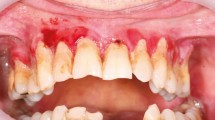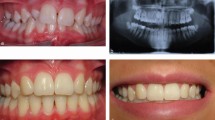Abstract
This article aims to describe common complicating factors that impact on the success of complete denture treatment and present an overview of the challenges these pose in practice. The authors present a range of medical, oral and social factors to consider when providing treatment to edentulous patients, allowing the practitioner to identify cases which may require referral. The information is applicable to all dental practitioners, and is a useful aid to highlight complicating factors in individual patients and to make well-informed clinical decisions.
Key points
-
Dental practitioners must be able to assess complexity in complete dentures and plan care for individual patients.
-
Medical, oral and social factors all contribute to case complexity in complete dentures.
-
Knowledge of these factors, combined with the ability to identify these through patient assessment, may aid practitioners in making well-informed clinical decisions to support edentulous patients.
This is a preview of subscription content, access via your institution
Access options
Subscribe to this journal
Receive 24 print issues and online access
$259.00 per year
only $10.79 per issue
Buy this article
- Purchase on Springer Link
- Instant access to full article PDF
Prices may be subject to local taxes which are calculated during checkout

Similar content being viewed by others
References
Steele J, O'Sullivan I. Executive summary: adult dental health survey. 2011. Available at https://files.digital.nhs.uk/publicationimport/pub01xxx/pub01086/adul-dent-heal-surv-summ-them-exec-2009-rep2.pdf (accessed February 2021).
UK Government Office for Science. Future of an Ageing Population. 2016. Available at https://assets.publishing.service.gov.uk/government/uploads/system/uploads/attachment_data/file/816458/future-of-an-ageing-population.pdf (accessed February 2021).
Clark R K, Radford D R, Juszczyk A S. Current trends in complete denture teaching in British dental schools. Br Dent J 2010; 208: E10; discussion 214-215.
Wieder M, Faigenblum M, Eder A, Louca C. An investigation of complete denture teaching in the UK: part 1. A survey of undergraduate teaching. Br Dent J 2013; 215: 177-181.
Wieder M, Faigenblum M, Eder A, Louca C. An investigation of complete denture teaching in the UK: part 2. The DF1 experience. Br Dent J 2013; 215: 229-236.
Gilmour A S, Welply A, Cowpe J G, Bullock A D, Jones R J. The undergraduate preparation of dentists: Confidence levels of final year dental students at the School of Dentistry in Cardiff. Br Dent J 2016; 221: 349-354.
Ali K, Slade A, Kay E, Zahra D, Tredwin C. Preparedness of undergraduate dental students in the United Kingdom: a national study. Br Dent J 2017; 222: 472-477.
General Dental Council. Standards for the Dental Team. 2013. Available at https://standards.gdc-uk.org/Assets/pdf/Standards%20for%20the%20Dental%20Team.pdf (accessed February 2021).
Celebić A, Knezović-Zlatarić D, Papić M, Carek V, Baucić I, Stipetić J. Factors related to patient satisfaction with complete denture therapy. J Gerontol A Biol Sci Med Sci 2003; DOI: 10.1093/gerona/58.10.m948.
Jayaraman S, Singh B P, Ramanathan B, Pazhaniappan Pillai M, MacDonald L, Kirubakaran R. Final-impression techniques and materials for making complete and removable partial dentures. Cochrane Database Syst Rev 2018; DOI: 10.1002/14651858.CD012256.pub2.
Regis R R, Cunha T R, Della Vecchia M P, Ribeiro A B, Silva-Lovato C H, de Souza R F. A randomised trial of a simplified method for complete denture fabrication: patient perception and quality. J Oral Rehabil 2013; 40: 535-545.
van Waas M A. The influence of psychologic factors on patient satisfaction with complete dentures. J Prosthet Dent 1990; 63: 545-548.
Fenlon M R, Sherriff M, Newton J T. The influence of personality on patients' satisfaction with existing and new complete dentures. J Dent 2007; 35: 744-748.
Al-Omiri M K, Sghaireen M G, Al-Qudah A A, Hammad O A, Lynch C D, Lynch E. Relationship between impacts of removable prosthodontic rehabilitation on daily living, satisfaction and personality profiles. J Dent 2014; 42: 366-372.
al Quran F, Clifford T, Cooper C, Lamey P J. Influence of psychological factors on the acceptance of complete dentures. Gerodontology 2001; 18: 35-40.
Nakayama Y, Washio M, Mori M. Oral health conditions in patients with Parkinson's disease. J Epidemiol 2004; 14: 143-150.
Packer M, Nikitin V, Coward T, Davis D M, Fiske J. The potential benefits of dental implants on the oral health quality of life of people with Parkinson's disease. Gerodontology 2009; 26: 11-18.
Edwards J A, Ford L, Boyle C. Dementia and Dentistry. Dent Update 2015; 42: 464-468, 470, 472.
Plemons J M, Al-Hashimi I, Marek C L. Managing xerostomia and salivary gland hypofunction: Executive summary of a report from the American Dental Association Council on Scientific Affairs. J Am Dent Assoc 2014; 145: 867-873.
Al-Dwairi Z, Lynch E. Xerostomia in complete denture wearers: prevalence, clinical findings and impact on oral functions. Gerodontology 2014; 31: 49-55.
Yamaga E, Sato Y, Soeda H, Minakuchi S. Relationship Between Oral Health-Related Quality of Life and Usage Period of Complete Dentures. Int J Prosthodont 2019; 32: 327-332.
Crum R J, Rooney Jr G E. Alveolar bone loss in overdentures: a 5-year study. J Prosthet Dent 1978; 40: 610-613.
Cawood J I, Howell R A. A classification of the edentulous jaws. Int J Oral Maxillofac Surg 1988; 17: 232-236.
Atwood D A. Postextraction changes in the adult mandible as illustrated by microradiographs of midsagittal sections and serial cephalometric roentgenograms. J Prosthet Dent 1963; 13: 810-824.
Leyssen W, Butt K, Walmsley A. Is a Ridge Classification Helpful when Assessing Edentulous Patients? Dent Update 2020; 47: 326-332.
Lynch C D, Allen P F. Management of the flabby ridge: using contemporary materials to solve an old problem. Br Dent J 2006; 200: 258-261.
Gahan M J, Walmsley A D. The neutral zone impression revisited. Br Dent J 2005; 198: 269-272.
Hegde C, Prasad K, Prasad A, Hegde R. Impression tray designs and techniques for complete dentures in cases of microstomia - A review. J Prosthodont Res 2012; 56: 142-146.
Nayyar J, Clarke M, O'Sullivan M, Stassen L F A. Fractured root tips during dental extractions and retained root fragments. A clinical dilemma? Br Dent J 2015; 218: 285-290.
British Society for the Study of Prosthetic Dentistry. Guides to Standards in Prosthetic Dentistry - Complete and Partial Dentures. 1996. Available online at https://www.bsspd.org/About/BSSPD+guidelines.aspx (accessed February 2021).
Johansson A, Omar R, Carlsson G E. Bruxism and prosthetic treatment: a critical review. J Prosthodont Res 2011; 55: 127-136.
Allen P F, McMillan A S. A longitudinal study of quality of life outcomes in older adults requesting implant prostheses and complete removable dentures. Clin Oral Implants Res 2003; 14: 173-179.
Author information
Authors and Affiliations
Contributions
Mr Mark Bishop: conceptualised and contributed to the writing of the paper. Mr Jonathan Dixon: contributed to the writing of the paper. Miss Bhavisha Mistry: contributed to the writing of the paper.
Corresponding author
Ethics declarations
The authors declare no conflicts of interest.
Rights and permissions
About this article
Cite this article
Bishop, M., Dixon, J. & Mistry, B. Complicating factors in complete dentures: assessing case complexity. Br Dent J 231, 451–455 (2021). https://doi.org/10.1038/s41415-021-3528-4
Received:
Accepted:
Published:
Issue Date:
DOI: https://doi.org/10.1038/s41415-021-3528-4



